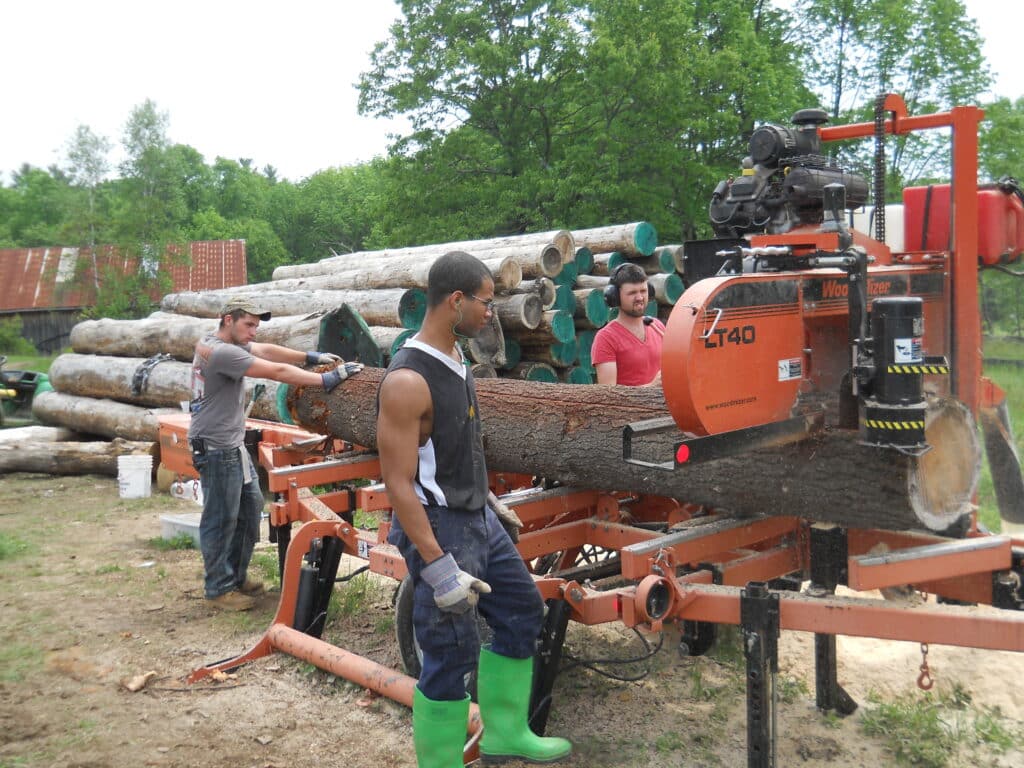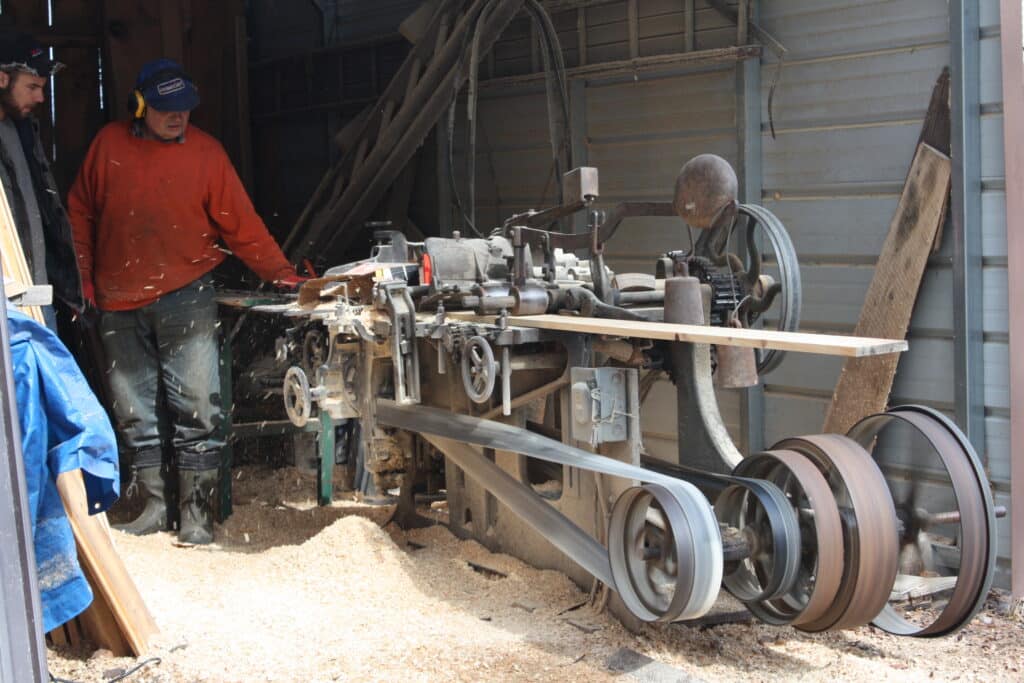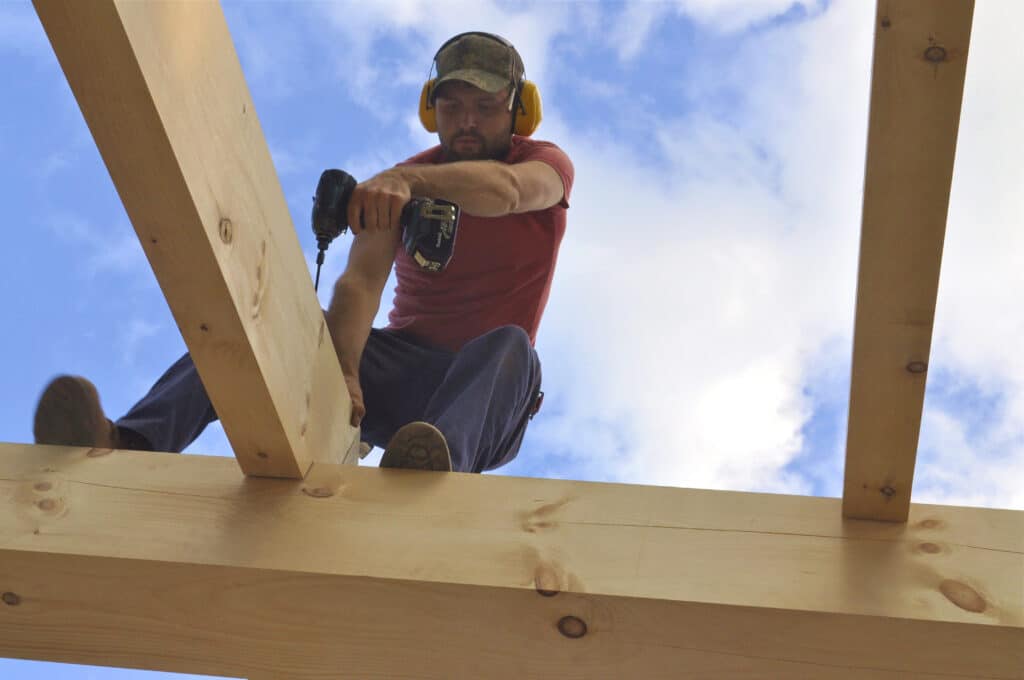The Beginnings of Promise Woods
After volunteering at camp for a year and a half in 2007–2008, Kenton Baer returned as construction supervisor to take on a much larger project: building the first cabin in the area that would become known as Promise Woods. “The decision to go back to camp in 2012 was quite simple,” Kenton said. “It was just perfect timing in my life to do a project like this. The motivation came from falling in love with camp and all that camp stands for in my previous stay.”
When Jim Baer—Kenton’s father—lived at camp, he was part of a group that had discussed and dreamed about the building of cabins for children’s camp at the setting where Promise Woods now exists. Rough plans had even been drawn up.
“I was not aware in the beginning that when my dad lived at camp he was on a committee that wanted to build cabins at that same spot,” Kenton said. “He even drew up a rough sketch of the plans. That made it extra special for me, for sure. I don’t know how many people get to complete something like that, so long in the making. What are the odds that I’d get to complete part of my dad’s vision 30 years later?”
“I’ve never had any official schooling for building, and I’d never built a stand-alone building before the cabin at camp. I had built a tiny log cabin at home. I just decided to take it on. I like to learn as I go, and I’ll take something on whether I’ve done it before or not. I have to thank my dad, though, for being the best teacher ever. And what is special about camp is whether you know what you’re doing or not, you can figure it out when you’re there. If you’re the only one there to do it, you do it.
“When I arrived at camp in 2012 they had a concept drawing of the cabins. I spent a few weeks tweaking those initial plans and along with Sean and Ken’s insight we came up with a more revised version to take to an architect. At this point the project suddenly became difficult. Initially camp was working with a Pennsylvania timber framing company as the architect. After we met with them about the drawings, we quickly realized they were not going to be able to provide us with what we needed to build a commercial building in New York state.
“At that point we decided to sit down and draw the buildings by hand in hopes that if we had actual sketches it would be easier to convey our plan to the next company. We then found a local guy that was more than qualified to make up these simple cabin drawings. The problem was he was probably over qualified and a bit out of touch with our reality. I believe in his mind we were building skyscrapers that needed every little detail specified to astringent standard. He wanted me to take some steps that were just not necessary for a small cabin.“
Anyway, we finally ended things with him and were on to the next guy. At this point we were all pretty discouraged about the situation. Thankfully the next architect was the perfect fit. He understood our vision for the project and was just a joy to work with. He was happy to take all the suggestions and plans we had made and turned them into what we needed to proceed.
“Using white pine from camp to build the cabins was such a joy. To be able to tell people that all the wood they see in the cabins was grown and cut at camp, and never went farther than the bottom of Brandt Road—to Dennis Smith’s for milling—was so satisfying. Using our own wood was definitely a learning process, with a few mistakes made. Camp initially cut down way too many trees before the project was underway and in doing so lost a lot of wood to bugs and nature doing its thing. This was not, however, a totally bad thing. As I began to realize the logs were becoming unusable for building, I became more selective and picked out just the best logs for sawing. This made for more wasted material, but in the end I was able to get a higher grade of lumber for the cabins. We also were able to make mountains of wood chips out of the less desirable logs, which were used for walking trails and mulching all around the camp property. So in the end our mistake was not all bad!
“One thing I will say is that working with volunteers changed me. I’m the first to admit I’m not very good with working with volunteers. To coordinate a group and work together is not my strong suit. I’ll never forget the first group of volunteers I worked with. I wasn’t prepared and about 20 things went wrong. In the end it worked out, but I redid some things and maybe ruffled some feathers. But I improved over time and one of the greatest perks of working on the cabin project was getting to work alongside many skilled volunteers. I learned so much from them—everything from plumbing and electrical skills to how to perfectly tuck a pencil under my hat for quick and easy access on the job!”
When asked if there were any design elements he was especially pleased with, Kenton noted, “The porches were originally supposed to be smaller. We were able to make them larger and I’m happy that we did that. People like to sit on porches and enjoy the scenery and each other’s company. And something a bit funny is a fancy door I made which leads to the mechanicals loft; it’s above the bedroom and you need a ladder to access it. I didn’t mean for it to look so inviting. It’s only about 4’ high. But everyone wants to go up there when they see the door. There are just wires and maintenance items in there.”
Kenton ended up building four cabins and lived in the maintenance house on the top of the hill for just under three years, until July of 2015. “I hadn’t committed to that,” said Kenton, “and maybe that lack of planning drove Ken a little crazy, but it worked out.” Ben Cheek replaced Kenton in 2015 and is presently working on the fifth and sixth cabins as well as the program center.
“I appreciate everything about camp, especially the variety of people,” Kenton said. “People come from everywhere. And they all come there and enjoy the same thing—beautiful mountains and the big front yard. Every-one seems to have a meaningful time there. I was not involved with summer camp, but seeing kids running around and having a blast—that made it for me.”
“I didn’t sleep in one of the cabins until over a year after they were in operation. It was nice to finally get to enjoy a night in something I put so much thought and time into. I hear comments about the cabins when I’m at camp, or even once at my church in Pennsylvania when someone let me know they had liked staying in one of the cabins during a visit to camp. I know the cabins are definitely appreciated.”
—Written by Donna Stoltzfus, former camper and staff.
Kenton Baer, volunteer 2007–08, Promise Woods construction supervisor 2012–2015.
Related Entries
Share:
“How Do I Donate?”
Recently, a thirteen-year-old guest at Camp asked Operations Director Kevin Smith, “how do I donate?” Kevin was honestly a little surprised, but was happy to see this young member – who was on retreat with one of our owning churches — taking some initiative. Kevin directed him to the website Donate page, and the young…
The Discipleship Down-Low
Defining Discipleship 18 And Jesus came and said to them, “All authority in heaven and on earth has been given to me. 19 Go therefore and make disciples of all nations, baptizing them in the name of the Father and of the Son and of the Holy Spirit, 20 teaching them to observe all that I have commanded…
The Virtuous Wife
This past weekend, Camp hosted three women’s retreats at Camp. Though the retreat groups were very diverse in background – one was from an urban church plant in Philadelphia, one was from a Garifuna Mennonite church in Brooklyn (an Afro-Caribbean Culture), and one was from a multi-ethnic faith community reaching out in North Jersey. Though…
A Life of Service
I believe the most important thing to God is not our personality, knowledge, or talents, but our availability. How willing and ready are we to respond when He calls, and how ready are we to do what He says? What use to the Lord are people who could do what he wants with excellence and…
Building Belonging
At our February NYC LMC District meeting, we’re discussing the Belonging phase of The Journey Map. In this first phase on the map, individuals and groups on a spiritual journey begin the process of connecting to each other and evaluating the place they may have in each other’s lives. Have you ever been an outsider…
What Are You Tapped Into?
Yesterday we began tapping maple trees, officially opening maple syrup making season at Camp Deerpark! Last year, the transition kept us from producing syrup, so it feels great to be back to it. Starting off, however, has been a bit of a challenge since things are pretty arctic around here. The entire ground is covered…
What Does it Mean to be Spirit-Led with Pastor Mark Perri
One small contribution I can make is to share story with you. This could be valuable in several ways: First, I’m coming to the Mennonites from the outside — from non-denominational GenX “simple/ organic/ emergent church“. Sometimes people coming from outside-in have a helpful perspective for those trying to move from inside-out. Second, as an…
2025 NYC LMC District Call Schedule
Mark these dates in your calendar if you’re part of the NYC LMC District and want to attend the English-language fellowship and resourcing calls led by Bishop Hyacinth Stevens: January 27th – 6:30 PM February 24th – 6:30 PM March 31st – 6:30 PM April 28th – 6:30 PM May 19th – 6:30 PM June 30th…
Winter: Life Under the Surface
On the surface, winter with its cracking and cold seems like the enemy of life. Everything sleeps as though dead, and Camp — quiet and empty — sits waiting. But under the surface, winter is revealed to be a friend to life, not an enemy. In the deep frost, God opens the soil for Spring’s…
Peace Making Presents
This is Session 4 of the Prince of Peace: Jesus and Peacebuilding from the Election to the Holidays webinar series. Advent celebrates the central fact that God began building peace with us by giving a Gift. Following this example, gifts are a powerful tool for peacebuilding in our lives, relationships, and organizations. We’ll explore how…





